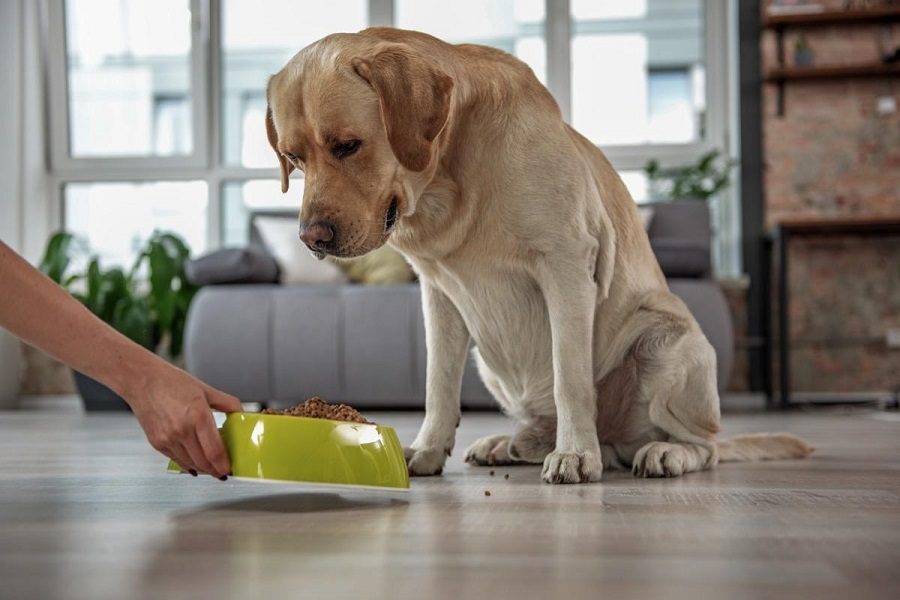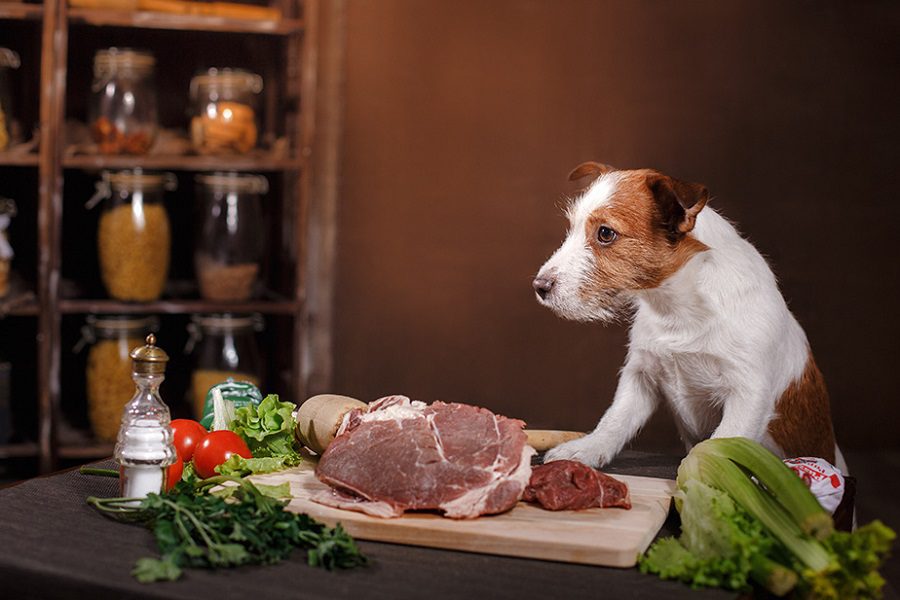Last Updated: 2 years ago
It’s not surprising that the decision what to feed your pet is a complex one.
There are dozens of pet food companies claiming that choosing their brand is choosing best dog food possible.
Like humans, dogs too have different nutritional requirements based on their activity level, age, genetic makeup, and health conditions. The food you choose should satisfy your pet’s nutritional needs as well as his emotional needs.
So, how to choose healthy dog food?
There’s No One Magic Formula
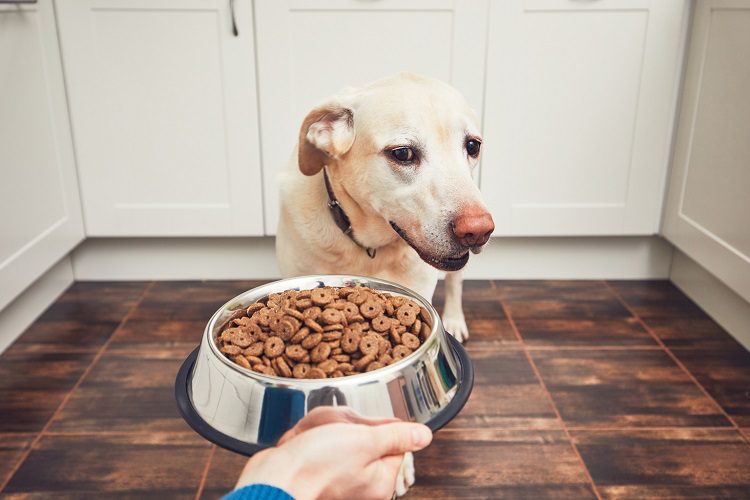
The dog food you choose should be appropriate for your dog’s age and nutritional requirements.
For example, a puppy eating dog food formulated for senior dogs will not get the right amount of calories, protein, vitamins and other essential minerals he needs for proper growth. On the other hand, an adult dog that eats premium puppy food is more likely to become overweight.
Look At The Ingredients
While sorting the different types of dog food – canned, dry and wet, reviewing the ingredients listed on the back of the can or bag is a good place to start.
First, you need to check the dog food label for the nutritional adequacy statement. This statement describes whether dog food is adequate for your pet.
For example, “this dog food is complete and balanced for puppy maintenance.” Remember that pups and senior adults have different nutritional requirements and it is important that you choose your dog’s food accordingly.
It’s Time To Shop Smart
If you want to improve your pet’s health, this is the right time to select a dog food that has AAFCO certification. Yes, you need to look for products that are AAFCO certified to make sure the food meets the basic vitamins and trace mineral requirements.
Of course, most commercial dog foods have a long list of ingredients and it’s always good to learn more about the ingredients that are being added.
The more you know about ingredients, you can identify ones that are inappropriate for your pet as well as ones that are allergenic and even toxic for your pet.
What You Need To Look For In Dry And Canned Dog Food
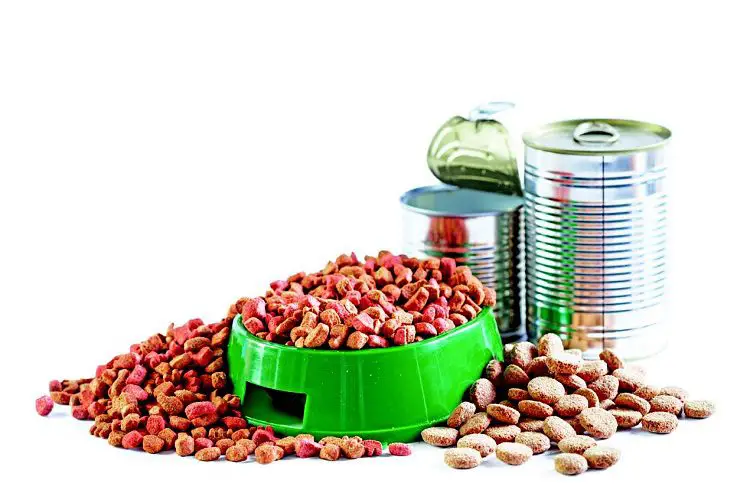
Dogs love meat and more meat. Yes, you’ve guessed it right. Dogs are carnivores and they absolutely love food that is based on meat. Technically dogs don’t like carbohydrates and they don’t really need carbohydrates for good health.
It is also seen that carbohydrates, for example, grains are added to pet food because they’re cheap and they increase the bulk of the food. Grain can cause food allergies and upset the digestive tract so it is better if you avoid dog foods that contain large amounts of carbohydrates.
The source and more importantly, the quality of protein used in dry as well as canned dog food is crucial for your pet’s health.
You need to look for high quality protein sources like beef, chicken, lamb and turkey. Beef perhaps is at the very top of the nutrient list because it contains all ten essential amino acids critical for your furry ball’s growth.
All meat ingredients should be clearly labeled on the dog food label. If you find dry and canned foods that use generic terms like meat or animal meat, drop the idea of buying them and start looking for a healthier option.
Vegetables can be included with meat and to be on the safer side, avoid dog foods that include grains. If you cannot find a grain-free product, go for a whole grain or organic dog food like brown rice. Organic grains are healthy but they cannot substitute the goodness of protein or meat content.
The most common carbohydrate source used in grain-free dog food is potato. The starch from potatoes helps hold the food particles together.
Avoid Soy And Corn
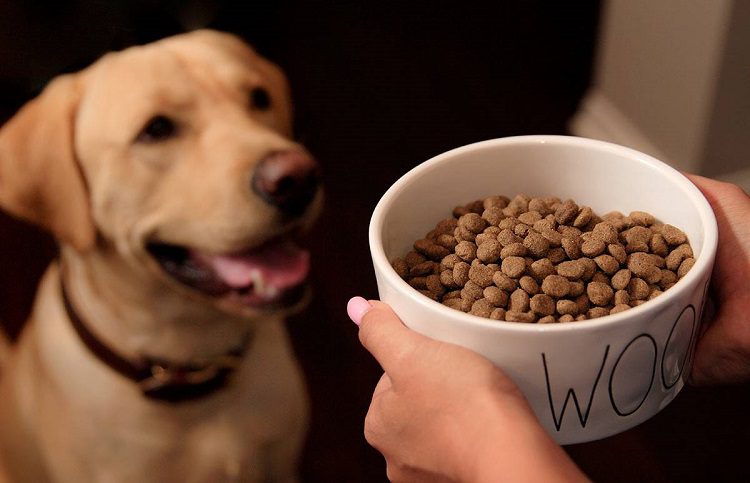
Soy should be avoided at all costs because it can mess up your pet’s endocrine system. Corn on the other hand is a cheap filler ingredient and doesn’t offer much nutritional value.
What’s worse is that corn is a well-known allergy-causing ingredient and it can put your canine friend’s health at stake.
Meat By-products Are A Big No – No
If canned dog food or dry food label clearly states “meat by-products” and doesn’t specify the type of meat or the specific part of meat used, you need to walk away from the product ASAP.
Remember that unspecified meat by-products can include parts of feet, beak, feathers and even hair and tumors which are anything but healthy for your furry ball.
On the other hand, offal such as spleen or other organ meat can be healthy and provide nutrition, but it’s good to avoid them as well.
Steer Clear Of Preservatives
Most artificial flavors, sweeteners and preservatives are known carcinogens.
Make sure you read the label clearly and avoid dog foods that contain BHA, BHT, ethoxyquin and Propyl gallate. Instead, look for dry and canned dog foods that contain natural preservatives like vitamins C and E.
8 Most Important Dog Food Ingredients
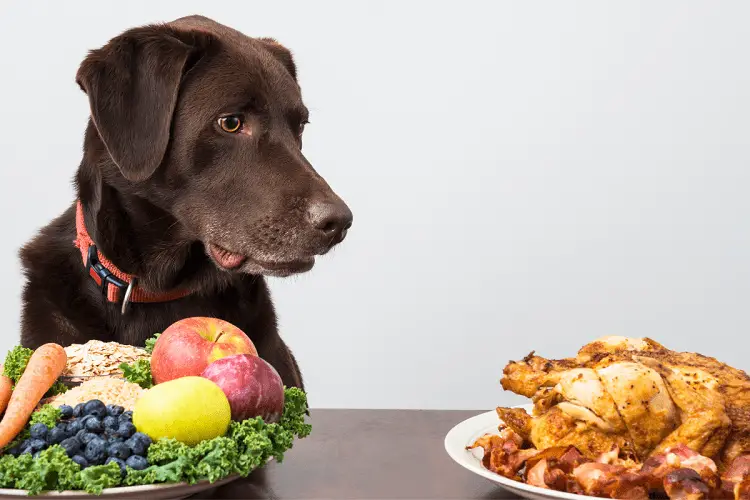
Your furry ball will eat just about everything you put in his bowl and this includes fruits, vegetables, table scraps and dog food.
Needless to say, what goes inside your pet serves as a foundation for their good health and well-being.
Perhaps the best thing you can do is educate yourself about the type and quality of ingredients used in the food you’re giving your pet.
Moreover, this is possible when you understand the ingredients your dog consumes. Here are the eight most important ingredients that need to be present in your dog’s food.
1. Proteins
Well, this shouldn’t be surprising. High quality protein products such as beef contain all ten essential amino acids that are important for the overall health of your pet.
There are a total of 22 amino acids involved in a dog’s metabolism out of which 10 essential amino acids by supplied by high quality protein in the diet. The remaining 12 amino acids are easily manufactured by the dog’s liver.
Protein in dog food can come from a variety of sources such as chicken, turkey, salmon, beef, rabbit and duck. Some commercial products are made using ‘meat meal.’
Simply put, original fresh meat is dried up to remove moisture and the product is then added as ground meat. As you can guess meat meal can never equal the goodness of real meat, but it’s not bad for your pet.
Again, you need to have a closer look at the ingredient list to get an idea of what’s included in your dog’s food.
Is Too Much Protein In Dog Food Bad For Your Pet?
Interestingly there’s no general agreement among pet nutritionists regarding what classifies as ‘too much’ protein in your pet’s diet.
Studies show that dogs unlike other canine species have a higher tolerance and capacity for digesting meat and protein on a dry weight basis.
Dry weight here means protein without moisture. It is seen that dry dog food usually contains 10% moisture. This number is increased to a whopping 74% in the case of canned dog food or wet food.
The bottom line is that protein intake is crucial for your pet’s health. So whatever dog food you choose, make certain that high quality protein – beef, lamb, salmon, chicken, duck or turkey is included as the main ingredient.
2. Fruits
Fruits are not as critical for your pet’s health as protein or vitamins and minerals. However, blueberries and even apples can be given to your canine pal as healthy treats.
Your dog will benefit from the fiber contained in fruits, but it is not advisable to give cherries or grapes to your pet, as they can be toxic.
3. Carbohydrates
Some species are gluten intolerant and there are chances that your pet is allergic to certain carbohydrates, grains in particular. As a precaution, avoid dog foods that contain an excessive amount of grains like corn or soy.
You can feed small amounts of oats, rice, wheat, or barley to your pet to improve digestive health. Complex carbohydrates such as whole wheat are also an excellent source of energy.
4. Vegetables
Vegetables are an excellent source of vitamins and minerals and can be added to your pet’s diet. However, make sure the dog food you choose doesn’t contain mushrooms, garlic and onions. Yes, these rather flavorful vegetables can be highly toxic to your pet.
5. Good Fats
Fats have a bad reputation, but not all fats are bad for your canine friend. Ideally, dogs require certain essential fatty acids to maintain shiny coat and allergy free skin.
If you find dog foods that contain essential omega 3 and omega 6 fatty acids, it indicates that the product is high quality dog food and will help your pet maintain a pretty, healthy coat.
Most common essential fatty acids are an excellent source of energy and encourage vitamin absorption. You are most likely to find fish oil, vegetable oil, flaxseed oil and soybean oil listed as an energy sources.
6. Vitamins
Vitamins and trace minerals without a doubt are essential ingredients because they help your pet maintain good health.
Studies show that B vitamins in particular help with digestive and immune system activity in dogs. B vitamins are also required for healthy metabolism and healthy nervous system.
The dog food you select should contain B vitamins in the form of riboflavin, biotin, thiamin and pyridoxine. Vitamin A is another important ingredient that should be present in your dog’s food.
Beta-carotene – one of the most efficient precursors of vitamin A is a common ingredient in high quality dog foods and helps your canine pal maintain healthy and shiny skin and coat.
According to the FDA, if your pet already eats a balanced diet, it doesn’t require additional vitamin or mineral supplements. However, if your furry ball has vitamin or mineral deficiency, you can always check in with a qualified vet to determine if a supplement is needed.
7. Minerals
Basically, there are two groups of minerals – macro-minerals and trace minerals.
As the name suggests, macro minerals are required in larger amounts and include magnesium, sodium, calcium, phosphorus and sulfur.
Finding The Right Minerals In The Best Dog Food
Trace minerals are needed in much lesser quantities but they are critical for growth and nervous system function. They include zinc, copper, iodine, chromium, fluorine and selenium.
Calcium and phosphorus possibly are the most important macro-minerals for dogs. Even a small deficiency in either of these elements can lead to bone deformities and fractures.
In addition to maintaining bone health, phosphorus and calcium are required for muscle growth, blood coagulation and brain function in dogs.
Most skin conditions in dogs are caused by sulfur deficiency. Dietary sources of sulfur include fish, eggs, meat and molasses.
Manganese, a trace mineral supports immune system function and is needed for the absorption of vitamins B, C and E.
Zinc is also needed for protein digestion, immune system function and to maintaining healthy skin and coat. Studies show that copper plays an important role in bone growth and maintenance and is necessary for the proper use of iron.
8. Water
This sounds surprising but water is one of the most important ingredients of dog food.
Canned food contains more than 70% water, but you should maintain a fresh drinking water supply for your pet at all times.
What Are The Different Types Of Dog Food?
Presently, there are three different types of dog food used in the pet industry including canned food, dry food and semi-moist foods.
Canned foods are sold in solid or soft containers and contain more than 70% water. Dry dog food is sold in a bag and contains less than 10% moisture. Semi-moist dog food is sold in soft pouches and contains 25 to 30% water.
Most dog foods are sold as complete and balanced products. Studies show that your canine friend requires 38 nutrients daily. If the food label states “complete and balanced”, it means that the product contains all of the required nutrients more importantly in the required quantities.
Again, you have to read the label carefully to confirm whether the food you choose is right for the age of your pet as well as activity level and nutritional requirements.
Your pet might have different preferences for dry and canned food. It is also important to remember that every food type has its own set of advantages and disadvantages.
Dry Dog Food
Dry dog food or kibble is the most convenient type of food for storage and feeding. You can leave dry dog food in the food bowl for your pet without worrying about spoilage. It is also more economical especially if you have multiple pets.
Dry kibble is also frequently used as an effective treat during training.
Of course, dry foods are convenient and economical, but they do not provide as much hydration as moist foods do. Dry dog food might not be the best choice for pets that are old or sick or those that live in hot, dry climates.
Canned Dog Food
Canned foods are generally more palatable and are a good alternative for pets that are picky eaters or have missing teeth and poorly aligned jaws.
Because canned foods also contain large amounts of water, they are a good source of hydration if your furry ball hates to go near his water bowl.
The right balance of protein, fats and water makes canned foods a good choice but there are a few disadvantages. There are chances your canine friend makes a mess while eating canned dog food.
On the other hand, you need to keep the open can covered and use it quickly before it spoils. Some dog owners also avoid canned dog food for the fact that it is not as economical as dry food.
Dog Food Rating
The Association of American Feed Control Officials (AAFCO) has established clear guidelines for dog food labels that companies can use.
For example, if dog food contains one ingredient, it should contain at least 95% of the ingredient excluding water. If a product contains a combination of ingredients, this combination should make up almost 95% of the total dog food composition.
In most cases, ingredients that contain large amounts of moisture such as meat (beef, chicken, or fish) are mentioned at the top of the list.
In case dog food advertises specific flavors, the product should contain only a detectable amount of the stated ingredient.
Always Pick Dog Foods That Provide Feeding Trial Info
Needless to say, foods that have undergone feeding trials are better choices for your pet.
Feeding trial information means that the product was fed to living dogs and that the dogs were willing to eat it and remained healthy after eating it. The dog food label should mention a statement indicating the nutrient profile and nutritional adequacy statement.
Fruits And Vegetables Dogs Can And Can’t Eat
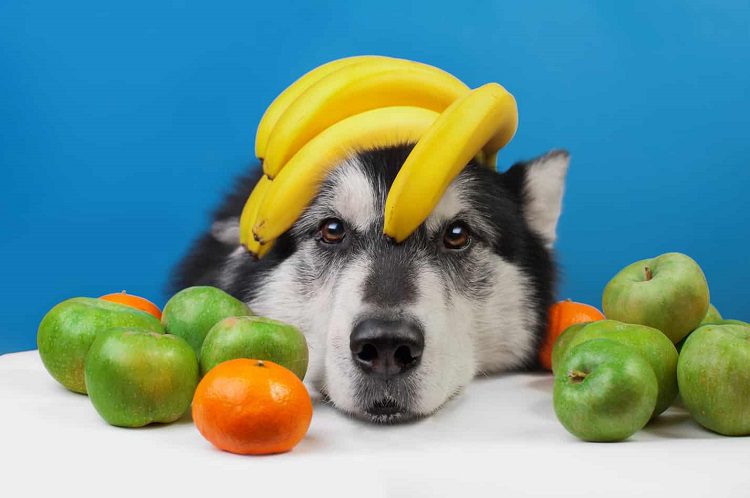
We covered all major fruits and vegetables that your pal can or cannot eat.
Can My Dog Eat Apples?
Of course, apples are safe for dogs. You can feed thin apple slices (remove core and seeds) to your pet as they are excellent sources of vitamins A and C. Apples are also a rich source of fiber and help maintain a healthy digestive tract.
Another good thing about apples is that they make perfect snacks for both pups and senior dogs.
Can My Dog Eat Bananas?
Bananas are low calorie treats and can be given to dogs in moderation. This soft fruit is one of the richest sources of potassium, vitamins, fiber and other vital trace elements like copper.
In addition, bananas are also low in cholesterol. Perhaps the only reason bananas should be fed in moderation is that they have high sugar content.
Can My Dog Eat Watermelon?
Yes, you can feed watermelon to keep your dog hydrated in hot summers, but make sure to remove the seeds and rind first*. Watermelons are healthy and are loaded with vitamins A, C and B as well as potassium.
That’s right. Watermelon is more than 90% water and is an ideal source of vitamin A, vitamin C, vitamin B6, fiber, magnesium and potassium. In fact, it’s an excellent choice for keeping your pet hydrated when the outside temperatures are high.
*Watermelon seeds and rind can cause intestinal blockage in dogs.
Are Grapes Safe For My Pet?
Unfortunately, grapes and raisins are extremely toxic for dogs regardless of their age, breed or sex. Studies show that grapes can cause acute kidney failure in dogs which can be life threatening.
Therefore, no matter how tempting grapes might look, you should definitely keep them away from your pet.
Can Dogs Eat Strawberries?
Strawberries as you know are loaded with vitamin C and fiber. In addition, these bright red jewels contain powerful enzymes that can whiten your pet’s teeth.
Because strawberries contain higher amounts of sugar, it’s better to use them in moderation.
Can Dogs Eat Oranges?
It’s recommended that you remove the seeds and peel them before feeding oranges to your pet.
The good thing about oranges is that they are not toxic to dogs, but your pet can have an upset stomach if he eats too much of this fleshy fruit.
Can Dogs Eat Celery?
Celery perhaps is one of the best sources of essential vitamins and minerals including vitamin A, vitamin B, vitamin C, calcium, iron, sodium and phosphorus.
It helps improve heart health, lower blood pressure and fights cancer. Celery can be your best bet to freshen your doggie’s breath.
Can Dogs Eat Carrots?
Carrots are a rich source of beta-carotene, vitamin C, vitamin K and vitamin A. In addition, carrots are also high in fiber and potassium.
So if you are looking for a healthy treat to add to your dog’s diet, add a few carrots as they are great for skin, eyesight and for cleaning gums and teeth.
Make sure you remove the ends and wash the carrots thoroughly
You can cut carrots into bite size pieces and cook in boiling water for about 7 – 10 minutes so that they become soft. Steamed carrots are another wonderful food option.
Can Dogs Eat Green Beans?
These make a fantastic low calorie snack.
Remember, green beans are a great source of vitamin A, vitamin C, vitamin K, fiber and manganese and keep your canine friend healthy.
Are Blueberries Safe For Dogs?
Blueberries are a rich source of antioxidants, which prevent free radical damage
These magical treats are also loaded with healthy phytochemicals and fiber, which help slow down cellular damage in canines.
Can Dogs Eat Tomatoes?
Ripe tomatoes are considered safe for dogs but green tomatoes contain a toxic component called solanine.
While tomatoes don’t cause problems in small amounts, it’s always better to skip them to prevent your pet from getting sick.
Can My Pet Eat Pineapples?
Yes, your canine friend can have few chunks of pineapple as sweet treats, but make sure you remove the prickly skin first.
This tropical gem is packed with vitamins, minerals and fiber. Pineapples also contain an enzyme that makes it easier for the dog’s digestive system to absorb proteins.
Are Avocados Safe For Dogs?
Avocados make healthy snacks for humans, but they are extremely toxic to dogs. Yes, you should never feed avocados to your pet.
The skin and pit of the fruit contain a toxic substance that causes severe vomiting and diarrhea in dogs. The fleshy part of avocado doesn’t contain high amounts of this toxic substance but it is still too much for your pet to handle.
Can My Dog Eat Broccoli?
Broccoli is a wonderful vegetable and it can be given to your pet in small quantities. This veggie is high in fiber and vitamin C and low in fat. If you’re looking for a healthy, low calorie treat for your pet, broccoli is an excellent choice.
Remember that broccoli florets contain compounds that might cause gastric irritation in susceptible breeds. If you decide to feed broccoli to your pet, make sure you remove the stalks as they can cause esophageal obstruction.
Are Mushrooms Safe For My Pet?
Certainly, there are mushrooms that won’t hurt your dog, but you’ve got to remember that mushrooms are tricky. Your pet might happily gulp them down when given the chance but wild mushrooms can be extremely toxic for dogs.
Surprisingly only 50 – 100 species of mushrooms worldwide can hurt your pet (mushroom toxicity can even lead to death) but it’s always good to skip this ingredient altogether.
Can Cucumbers Be Added To Dog Food?
Cucumbers are low calorie vegetables and they are excellent for obese dogs.
In addition to water content, cucumbers are packed with useful minerals and vitamins like vitamin B1, vitamin C, vitamin K, magnesium, copper and potassium.
Are Onions Safe For Dogs?
The answer is a big NO!
Onions and even chives and leeks are highly toxic if ingested by your pet. In fact, onions are poisonous to most pets – including cats. Eating leeks, chives and onions can cause the red blood cells of your pet to rupture.
Early symptoms of onion poisoning include diarrhea, nausea, stomach pain and vomiting. All dogs are susceptible to onion poisoning but the symptoms are most severe in the Japanese breeds of dogs.
Can Dogs Eat Pears?
Pears make a healthy snack and are packed with vitamins K and C.
Eating pears can reduce the risk of your pet having a stroke by almost 50%. The best way to feed this fruit to your dog is to cut it into thin bite sized chunks and remove the pit and seeds.
It is recommended that you remove the seeds of pears as they contain traces of cyanide.
Are Potatoes Safe For Dogs?
Of course you can feed small amounts of cooked plain potatoes to your dog occasionally.
Cooked potatoes i.e. baked and boiled potatoes are excellent sources of iron. You should avoid feeding raw potatoes to your pet, as they can be little ‘rough’ on the digestive tract.
The last thing you should do is feed mashed potatoes to your pet. Yes, it’s better if you avoid feeding mashed potatoes because they are loaded with butter and ‘risky’ seasonings.
Can My Pet Eat Cherries?
Sadly cherries (with the exception of the fleshy part) are toxic to dogs because they contain cyanide. If your dog eats cherries, make sure you seek medical attention immediately.
Cyanide contained in cherries disrupts the oxygen carrying mechanism in dogs. Early symptoms of cherry poisoning include dilated pupils, breathing difficulty and swollen gums.
Can My Dog Eat Peaches?
A small amount of bite size peach chunks make a healthy treat and help keep your pet healthy. However, like cherries, the pit (of the fruit) contains cyanide, which might be toxic to your pet.
It’s always good to feed fresh fruits to your dog. Canned peaches and pineapples in particular contain high amounts of sugary syrups that might cause weight issues in certain breeds.
Can My Pet Eat Asparagus?
While asparagus are healthy for humans, there’s no point in feeding this vegetable to dogs.
Uncooked or raw asparagus is too difficult to chew and if you cook it before feeding your pet, the vegetable loses all its nutrition. A smart thing to do is go for vegetables that will actually benefit your pet in the long run.
Can Dogs Eat Sweet Potatoes?
Just like potatoes, you should only feed small amounts of washed, cooked, peeled and plain sweet potatoes.
Needless to say, you need to avoid delicious sugary treats such as pies and casseroles made using sweet potatoes due to their high sugar content.
Can My Pet Eat Raspberries?
Raspberries are low in sugar and calories and contain plenty of antioxidants and healthy minerals.
These fruits need to be given in moderation and are especially helpful for senior dogs. Studies show that raspberries contain anti-inflammatory compounds, which help relieve pain and discomfort associated with arthritis.
*Xylitol contained in raspberries can be toxic to dogs in high amounts so make sure you limit your dog’s intake of raspberries to less than a cup.
Conclusion
As a dog owner, you would only settle for the best dog food for your canine friend. Now that you know what you need to look for in dog food, here’s hoping that you can make a good decision.
Take your time to read the labels and choose a high quality dog food formulated by expert nutritionists. Remember, your right decision can help your canine friend live the longest and healthiest life possible.

